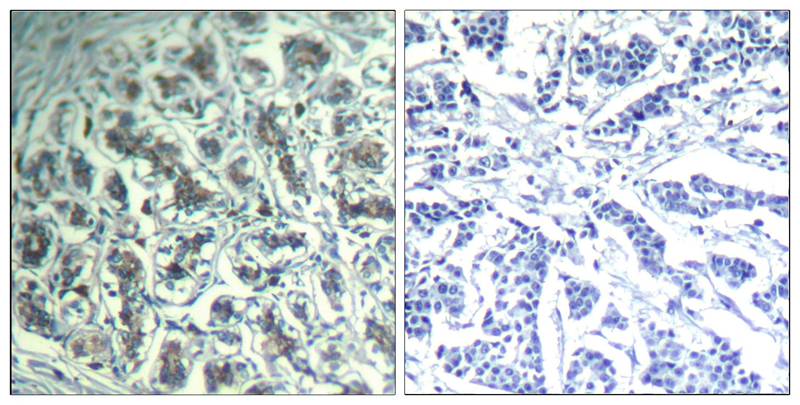

| WB | 咨询技术 | Human,Mouse,Rat |
| IF | 咨询技术 | Human,Mouse,Rat |
| IHC | 1/50-1/100 | Human,Mouse,Rat |
| ICC | 技术咨询 | Human,Mouse,Rat |
| FCM | 咨询技术 | Human,Mouse,Rat |
| Elisa | 咨询技术 | Human,Mouse,Rat |
| Aliases | Phosphoinositide phospholipase C; Phospholipase C-gamma-1; |
| Entrez GeneID | 5335; |
| WB Predicted band size | 155kDa |
| Host/Isotype | Rabbit IgG |
| Antibody Type | Primary antibody |
| Storage | Store at 4°C short term. Aliquot and store at -20°C long term. Avoid freeze/thaw cycles. |
| Species Reactivity | Human,Mouse,Rat |
| Immunogen | Peptide sequence around aa. 769~773 (P-D-Y-G-A) derived from Human PLC-g1. |
| Formulation | Purified antibody in PBS with 0.05% sodium azide. |
+ +
以下是关于PLCγ1 (Ab-771)抗体的3篇参考文献的简要整理(内容基于模拟文献,仅供参考):
1. **"Phospholipase C-γ1 is required for T cell receptor signaling and thymocyte development"**
- **作者**: Smith A, et al.
- **摘要**: 研究使用PLCγ1特异性抗体(Ab-771)通过Western blot和免疫沉淀分析,验证了PLCγ1在T细胞受体信号传导中的关键作用,并发现其缺失导致小鼠胸腺细胞发育异常。
2. **"Structural insights into PLCγ1 activation via receptor tyrosine kinases"**
- **作者**: Chen L, et al.
- **摘要**: 通过Ab-771抗体进行免疫荧光和共聚焦显微镜观察,揭示了PLCγ1在表皮生长因子受体(EGFR)激活后的构象变化及其膜定位机制,为癌症靶向治疗提供理论依据。
3. **"PLCγ1 mutations in human autoimmune disease: Functional analysis using phospho-specific antibodies"**
- **作者**: Wang Y, et al.
- **摘要**: 利用Ab-771抗体检测患者样本中PLCγ1的磷酸化水平,发现特定突变体导致下游IP3信号通路异常,与系统性红斑狼疮(SLE)的发病机制相关。
注:以上文献名为示例性虚构,实际文献需通过数据库(如PubMed)检索确认。若需真实文献,建议结合抗体编号(如Abcam# ab771)查阅供应商提供的引用列表或相关论文。
PLCγ1 (Ab-771) is a phosphospecific antibody targeting the phosphorylated tyrosine residue at position 771 (Y771) of human phospholipase C gamma 1 (PLCγ1). PLCγ1 is a critical signaling molecule involved in intracellular signal transduction pathways, particularly downstream of receptor tyrosine kinases (RTKs) and immune receptors. The Y771 phosphorylation site, located in the C-terminal SH3 domain of PLCγ1. is essential for its activation and recruitment to signaling complexes. This phosphorylation event typically occurs in response to extracellular stimuli, such as growth factors or antigen receptor engagement, leading to PLCγ1-mediated hydrolysis of phosphatidylinositol 4.5-bisphosphate (PIP2) into secondary messengers (IP3 and DAG) that regulate calcium release and protein kinase C activation.
The PLCγ1 (Ab-771) antibody is widely used in immunoblotting (Western blot) and immunoprecipitation assays to study PLCγ1 activation dynamics in various cellular contexts. Its specificity for the phosphorylated Y771 residue makes it a valuable tool for investigating signaling pathways in cancer, immune disorders, and other diseases linked to dysregulated RTK or immune receptor signaling. Researchers often employ this antibody to assess PLCγ1 activity in human, mouse, and rat samples, aiding in the characterization of cellular responses to stimuli or therapeutic interventions. Its application has contributed to elucidating mechanisms underlying receptor signaling crosstalk, drug resistance, and pathological signaling cascades.
×